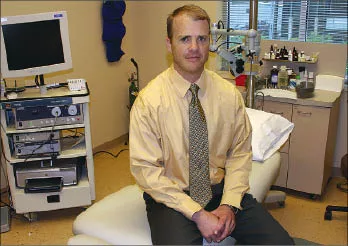Spokane Ear, Nose & Throat hears patient growth calling
After brief soft stretch, longtime practice back on strong upward track

Strengthened by recently expanded facilities here, Spokane Ear, Nose & Throat Clinic PS says it's positioned well to serve a patient load that has grown steadily over the last decade and shows no signs of plateauing.
The longtime practice experienced some brief softness in patient volume from about November through February, likely due to the tough economic conditions, CEO Rod Emerson says, but adds, "From March forward, we've really seen strong numbers."
If that growth continues, the doctors' group likely will seek to add a 13th physician, he says. It previously had 13 physicians for a time, but added a nurse practitioner, rather than a physician, when one of its longtime principals, Dr. Gary Cantlon, retired in December.
Over about the last decade, it has added five physicians, and they have been key contributors to its increased patient volume, Emerson says.
Counting the physicians, it currently employs a total of about 95 people at its three facilities here, he says. Those facilities include its three-story, 33,000-square-foot main clinic and surgery center, at 217 W. Cataldo, and two single-story, 7,000-square-foot clinics, one at 9922 N. Nevada, on the North Side, and the other at 13414 E. Mission, in Spokane Valley. It developed the $5 million facility on Cataldo about 10 years ago, and opened the North Side satellite facility in 2007 and the Valley clinic last August, both in buildings it developed at a cost of around $2 million each.
"We've seen good growth in the Valley. We've been pretty pleased with that," Emerson says. Along with providing a more convenient location for Valley and North Idaho patients, that added space has given the doctors' group the infrastructure to accommodate as many as 18 to 20 health-care providers overall, he says.
The opening of the Valley clinic required adding only one employee, a receptionist, because Spokane ENT has been able to staff that facility with teams from its other locations and use an electronic records system that it developed years ago to operate more efficiently.
Spokane ENT's physicians are specialists and subspecialists who offer services that range from hearing evaluations, speech therapy, allergy treatment, and tonsillectomies, to cochlear implants, head and neck cancer removal, and reconstructive and cosmetic facial plastic surgery. Emerson says the practice's patients aren't dominated by any particular age group and include a sizable number of children. Its health-care providers currently are seeing about 34,500 clinical patients a year, and its physicians—all of them surgeons—are performing about 4,500 surgeries annually, he says.
Those figures don't include patients seen at one of its affiliated Columbia Hearing Centers offices, which occupy space in each of the clinics it operates, plus one separate location on the South Hill, and dispense hearing aids.
Emerson estimates that about 80 percent of Spokane ENT's patients are referred by other doctors, but says most health-insurance plans now allow patients to schedule appointments and see providers there without needing to obtain such referrals.
Around 55 percent of the patients seen by the practice are covered by commercial insurers, and most of the rest are Medicare or Medicaid recipients or participate in other government-sponsored health-care assistance programs, he says. He adds that Spokane ENT also donates some services through Project Access, a network of doctors and hospitals that seeks to address the health-care needs of low-income, uninsured residents of Spokane County.
Spokane ENT's three-story main building north of downtown includes the outpatient surgery center on the first floor, a clinical center and the allergy clinic on the second floor, and administrative offices, some additional clinical space, and a Columbia Hearing outlet on the third floor. Also located on the top floor is the practice's facial plastic surgeon, Dr. John F. Hoffmann. On the second floor, along with exam rooms and other clinical-related space, the practice has a computed-tomography (CT) machine that it uses for various types of head and neck imaging, Emerson says.
It installed the computerized medical records system when it opened the new clinic. Physicians use computers installed in each exam room to look up a patient's medical history and to enter new information into the practice's central database.
The computers are linked through a network, and largely have eliminated the need for paper charts and files, Emerson says. The system also allows users to do things such as keep track of a patient's medications, print out prescriptions, fax a copy of a prescription to a patient's pharmacy, and send billing information to the practice's billing computer, he says.
Spokane ENT is owned jointly by 11 of its 12 physicians. It was founded in 1916, but Emerson says the bulk of its growth has occurred since 1995, when a separate practice called Ear, Nose & Throat Associates of Spokane merged with Spokane Ear, Nose & Throat Clinic. It established Columbia Hearing Centers as a separate, but affiliated entity about eight years ago, Emerson says.
Over the years, its fellowship-trained physicians have become more involved in subspecialties, such as rhinology, which deals with diseases of the nose and sinuses, and neurotology, involving neurological disorders of the ear, and that has helped it expand the geographical area from which it draws patients, he says.
Spokane ENT's services and the patients it sees are diverse enough that the practice likely won't feel any significant upswing in business from the aging of the baby boomer population, Emerson says. Potential health-care reform effects aside, the Inland Northwest's overall population growth and an anticipated coinciding rise in demand for the practice's specialized services will be what drives further increases in its volume, he says.
"Our model does show some good growth in coming years," he adds. "We feel positive about it. It's been a strong growth for a long time, and we don't see that really changing."
Related Articles

_c.webp?t=1763626051)

_web.webp?t=1764835652)
